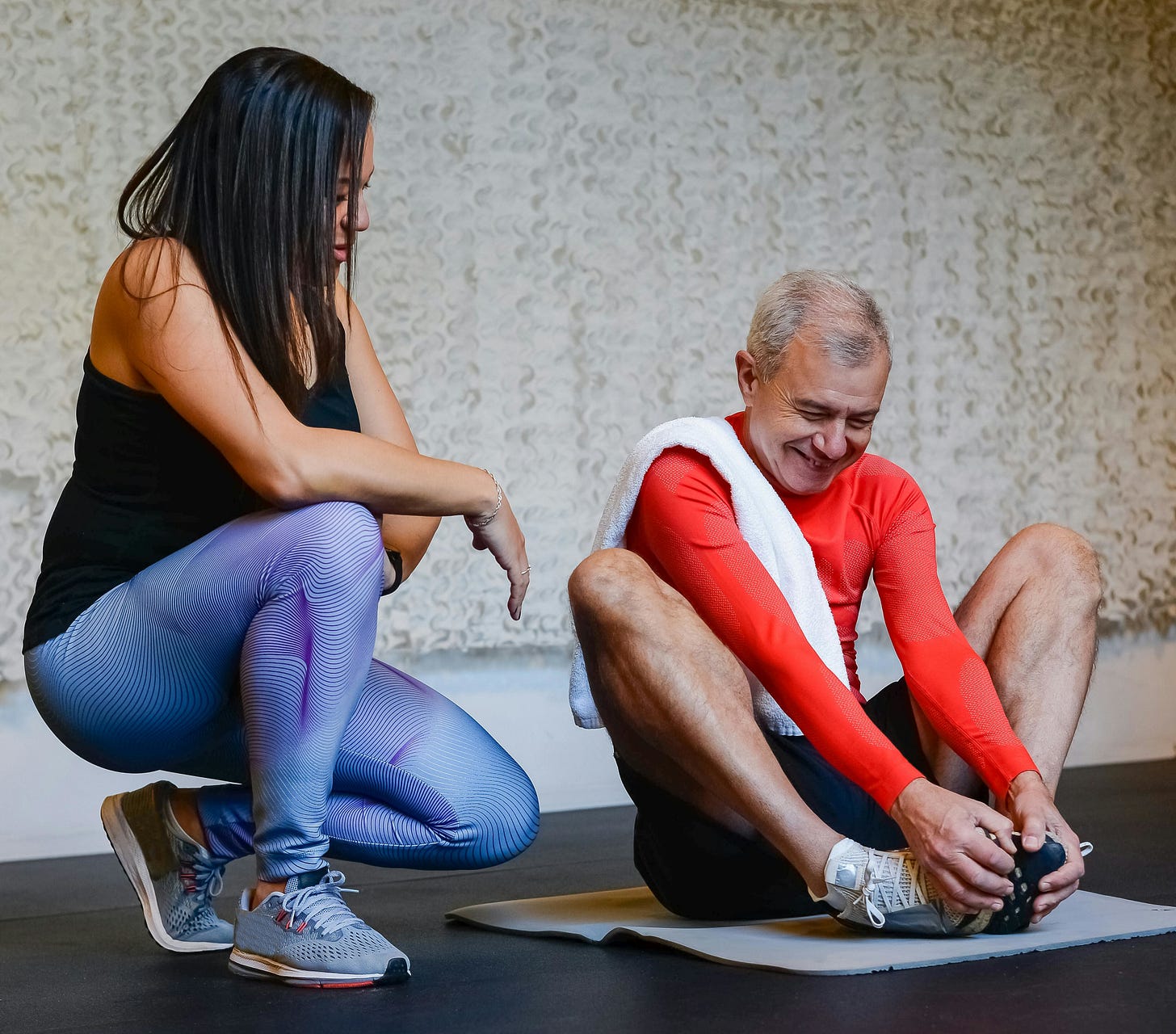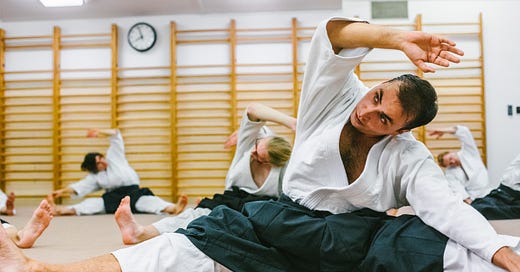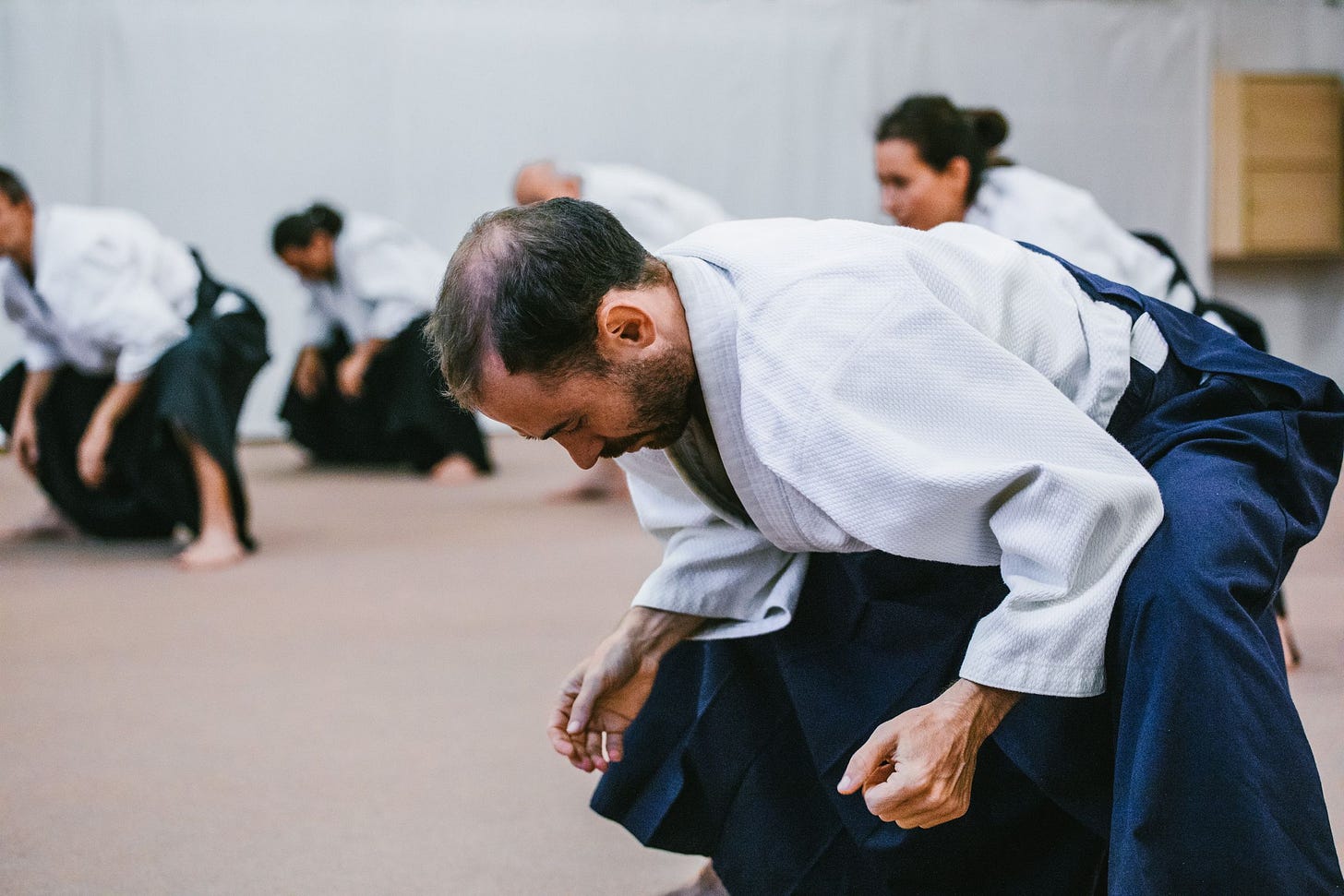Warm-up In Martial Arts: A Waste of Time or Essential Practice?
Body, Mind, Health, and Technique—It All Starts Here
Hello everybody!
It’s February, and winter has fully settled here in Prague—clear blue skies and freezing temperatures. The perfect time to talk about warming up!
Warm-ups in Aikido vary as much as dojos and teachers—you’ve probably seen many approaches.
I believe that warm-up connects directly to the quality of our movement, consciousness, physical literacy, and well-being. It's a topic worth our attention and I want to explore it with you today. But first…
Let’s Warm Up with Two Stories
When I was around 25 years old, I was occasionally attending morning classes in a dojo. There were 5-10 regulars around my age who saw themselves as tough aikidoka, believing that attending morning classes showed real dedication. And their badge of honor? Skipping the warm-up—because nothing says “hardcore” like diving straight in without preparation. The teacher would sometimes even start a class with koshi nage - which students cheered as a real challenge.
After 2-3 years, they all (including the teacher) quit Aikido due to back pain.
At the same time, in stark contrast, I witnessed Tamura Sensei who did warm-up for 30–60 minutes, blending Chinese and Japanese health exercises—and he clearly enjoyed it. Even at 75, he moved with sharpness and took ukemi.
What do these stories say about warm-ups? I leave their moral to your conclusions and I’ll move our attention to…
Some Reasons for (not) Warming-Up
1. Hey, Warriors Need No Warm-Up
Some people say that warm-up in martial arts is a nonsense because when attacked on the street we have no time to warm-up. And warriors in war should be prepared to fight all the time.
While it’s a very nice ideal to be physically 100% available every moment of our lives, let’s briefly consider that:
When we step into the dojo, we’re not on a street or a battlefield.
Most of us are not soldiers and rarely meet a street fight.
Our work often requires sitting all day, not physical movement as several decades or centuries ago.
I believe that the traditional warrior training, however it was, didn’t care how those warriors would suffer in their bodies in case they survived their service. And as we can live well over 70 in our civilization, we might take care of our bodies better than people in the ancient military.
2. Warm-Up Is a Waste of Time, We Warm-Up by Practice
Some dojos replace warm-ups by starting the practice with slow Aikido techniques with a partner. It’s better than jumping straight into koshi-nage—but only slightly.
Some years ago I did an involuntary experiment. I attended a class with a teacher who does some partner Aikido exercises instead of warm-up. I knew the stuff so I consciously did slow and tried to move my body as much as possible within the proposed framework. After this there was a normal Aikido class for some 50 minutes: techniques, all kinds of ukemi… and I considered myself to be fine.
Right after came another class held by a different teacher, who decided to have a pretty standard Aikido warm-up. And during this warm-up, I realized that the deep muscles in my legs and torso were completely stiff - as if they were not moving before at all.
Thus I personally think that Aikido techniques alone aren’t enough to warm up properly.
3. Pragmatic Reasons in Sports
Athletes and their coaches know that a warm-up serves four primary purposes1:
Mental readiness
Physical readiness
Injury and microtrauma2 prevention
Performance enhancement

Let’s get a bit scientific for a moment.
A proper and comprehensive warm-up increases blood flow and oxygen supply, enhances muscle elasticity, lubricates joints, gradually loads tendons and ligaments, activates the nervous system, and reduces lactic acid build-up.
Trust me, professional athletes warm up for a reason—they wouldn’t waste time otherwise.
Even though we aren’t sportspeople, we perform physical activities and use our bodies in Aikido. If we want to practice in a healthy and sustainable way, we might consider the sport science behind warm-ups and get inspired. Even the sports warm-up can be sometimes very poor example of what we really need3.
4. Beyond the Warm-Up - Tuning to Oneself
In his essay on the parallels between music and Aikido4, Franck Noël suggests that the warm-up is more than just physical preparation—it’s a time to “tune in to ourselves”: waking up the body, calming the mind, and sharpening perception.
Tamura sensei, when asked about his warm-up exercise, was even more specific and personal: “After doing the Jikyo Jutsu5 exercises, I am instantly able to hold myself in a natural and relaxed posture [...] It’s difficult when you practice with a partner, but when you practice them alone, you become able to see inside yourself.”6
That’s the key: warming up individually gives us time to explore our bodies, deepen our awareness, and unify mind and movement. This “seeing inside ourselves”, “tuning to ourselves” or “tuning to the present moment” is one of the goals of our practice and goes far beyond mere warming-up in sports.
5. Exploration and Constant Development
Since our energy and focus are fresh at the beginning of the class and as we exercise individually, the warm-up is the ideal time to explore and “learn” new movements.
This is where beginners can learn the basics of ukemi or taisabaki. This sensitive time is also great for advanced aikidoka to get deeper into their bodies and refine their coordination with new challenging exercises from Aikido, other movement arts, or animal walks.
Of course, this development is only possible in case some elements of warm-up change after some time, so that our bodies and brains get new impulses.
Let’s Get the Most Out of It!
Morihei Ueshiba stated in his precautions for training in 1938 that:
In daily training, begin with basic movements to strengthen the body without overexertion. Spend the first ten minutes warming up and there will be no fear of injury even for older people. Enjoy yourself in training and strive to comprehend its true purpose.7
Since then, Aikido warm-ups have evolved, incorporating Shinto purification, Aiki-Taiso, Jikyo Jutsu, Makko-Ho, Nishi Shiki, and other movement practices.
This evolution should continue—we should constantly refine and improve our warm-ups. Not just preparing muscles, but deepening our movement and awareness.
A good warm-up in our art should:
- Physically prepare the body for activity and prevent injuries
- Calm the mind and open perception to our inside as well as surrounding
- Interconnect body awareness and mental focus, unifying mind and body
- Expand the movement possibilities
In my classes, I do 5-10 warm-ups weekly and each is interesting for me. Why? Maybe because I try to get maximum from each single movement during those 10-20 minutes and I always search for new connections and improvements in the usual exercises.
A good warm-up isn’t just preparation—it’s an investment in our comfort, health, and long-term Aikido practice. In warm-up we have time to get deeper to ourselves and improve everything that we do later in the partner practice.
What do you think? If you’re teaching, how do you build your warm-ups and what is the reasoning behind it? Do you incorporate new inspirations and change things over time?
And if you’re a student - what warm-ups work for you and why?
Let’s share experiences and ideas in the comments!
This article contains some reasons to do a warm-up. In the near future, I plan to write about how we do different warm-ups for children, teenagers and adults in our dojo.
Related articles
Read more articles from the cycle Movement Development in Aikido
For example, in 90s, we used to practice Aikido with my friend Martin in a corner of tatami where Judo people had their class. Their warm-up was so enthusiastic and fast that it included the most frenetic movements of their whole training. I suspect that the most microtraumata were generated during the warm-up.
Essay “D’un Monde a l’autre” published in “Sur la voie” by Franck Noel in 2016
Jikyo-jutsu is an early type of exercise developed in Japan that incorporates elements of gymnastics, aerobics, and yoga. Google it and you’ll find some videos and charts that will look familiar to you.
More on the historical development of warm-up in Aikido and Tamura sensei attitude towards various preparation and health exercises at https://budojapan.com/feature-articles/20200914-2/
Morihei Ueshiba: Budo - Teachings of the Founder of Aikido, Kodansha International 1991






I absolutely agree with the idea mentioned in the comments - the older I´m, the more warm-up I need. I´m even getting to the stage when I need my morning warm-up every day. And I use our Aikido warm-up as inspiration for what I want to explore more at home.
Excellent blog post! I agree with your ideas on warm ups. The mental prep is as important as the physical. I am in my 50’s and can feel lots of old pain now. lol. Gotta take care of yourself so you can train for a long time. Thanks!